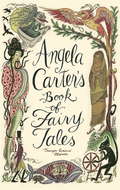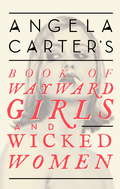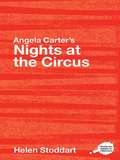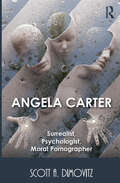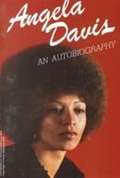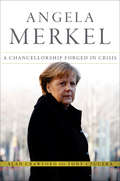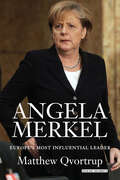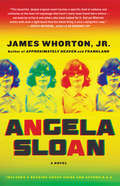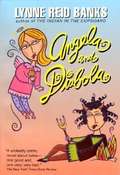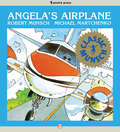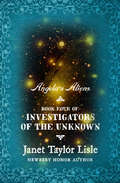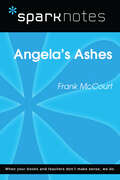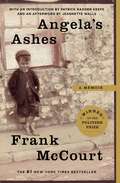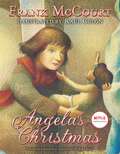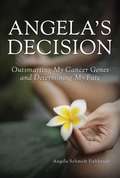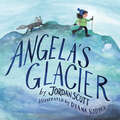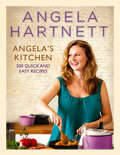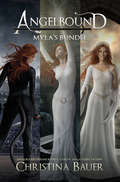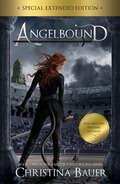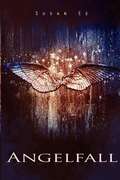- Table View
- List View
Angela Carter's Book Of Fairy Tales
by Angela CarterOnce upon a time fairy tales weren't meant just for children, and neither is Angela Carter's Book of Fairy Tales. This stunning collection contains lyrical tales, bloody tales and hilariously funny and ripely bawdy stories from countries all around the world- from the Arctic to Asia - and no dippy princesses or soppy fairies. Instead, we have pretty maids and old crones; crafty women and bad girls; enchantresses and midwives; rascal aunts and odd sisters. This fabulous celebration of strong minds, low cunning, black arts and dirty tricks could only have been collected by the unique and much-missed Angela Carter. Illustrated throughout with original woodcuts.
Angela Carter's Book Of Fairy Tales
by Angela CarterOnce upon a time fairy tales weren't meant just for children, and neither is Angela Carter's Book of Fairy Tales. This stunning collection contains lyrical tales, bloody tales and hilariously funny and ripely bawdy stories from countries all around the world- from the Arctic to Asia - and no dippy princesses or soppy fairies. Instead, we have pretty maids and old crones; crafty women and bad girls; enchantresses and midwives; rascal aunts and odd sisters. This fabulous celebration of strong minds, low cunning, black arts and dirty tricks could only have been collected by the unique and much-missed Angela Carter. Illustrated throughout with original woodcuts.
Angela Carter's Book Of Wayward Girls And Wicked Women
by Angela CarterThis bestselling collection of stories extols the female virtues of discontent, sexual disruptiveness and bad manners Here are subversive tales - by Ama Ata Aidoo, Jane Bowles, Angela Carter, Colette, Bessie Head, Jamaica Kincaid and Katherine Mansfield among others - all have one thing in common: the wish to restore adventuresses and revolutionaries to their rightful position as models for all womenReflecting the wide-ranging intelligence and deliciously anarchic taste of Angela Carter, some of these stories celebrate toughness and resilience, some of them low cunning: all of them are about not being nice.
Angela Carter's Book Of Wayward Girls And Wicked Women (Virago Modern Classics #71)
by Angela CarterThis bestselling collection of stories extols the female virtues of discontent, sexual disruptiveness and bad manners Here are subversive tales - by Ama Ata Aidoo, Jane Bowles, Angela Carter, Colette, Bessie Head, Jamaica Kincaid and Katherine Mansfield among others - all have one thing in common: the wish to restore adventuresses and revolutionaries to their rightful position as models for all womenReflecting the wide-ranging intelligence and deliciously anarchic taste of Angela Carter, some of these stories celebrate toughness and resilience, some of them low cunning: all of them are about not being nice.
Angela Carter's Nights at the Circus: A Routledge Study Guide (Routledge Guides to Literature)
by Helen StoddartA highly original and influential work of modern British literature, Angela Carter’s Nights at the Circus combines a fantastically creative plot with a strong political undertone. The result is an emotive and provocative novel, which has attracted much critical attention from a range of perspectives including poststructuralism, gender studies, postmodernism and psychoanalysis. This guide to Angela Carter’s complex novel, presents: an accessible introduction to the text and contexts of Nights at the Circus a critical history, surveying the many interpretations of the text from publication to the present a selection of new critical essays on the Nights at the Circus, by Heather Johnson, Jeannette Baxter, Sarah Sceats and Helen Stoddart, providing a variety of perspectives on the novel and extending the coverage of key critical approaches identified in the survey section cross-references between sections of the guide, in order to suggest links between texts, contexts and criticism suggestions for further reading. Part of the Routledge Guides to Literature series, this volume is essential reading for all those beginning detailed study of Nights at the Circus and seeking not only a guide to the novel, but a way through the wealth of contextual and critical material that surrounds Carter’s text.
Angela Carter: Surrealist, Psychologist, Moral Pornographer
by Scott DimovitzContributing to the conversation regarding Angela Carter's problematic relationship with what she viewed as the interrelated traditions of surrealism and psychoanalysis, Scott Dimovitz explores the intricate connections between Carter's private life and her public writing. He begins with Carter's assertion that it was through her "sexual and emotional life" that she was radicalized, drawing extensively on the British Library's recently archived collection of Carter's private papers, journals, and letters to show how that radicalization happened and what it meant both for her worldview and for her writings. Through close textual analysis and a detailed study of her papers, Dimovitz analyzes the ways in which this second-wave feminist's explorations of sexuality merged with her investigations into surrealism and psychoanalysis, an engagement that ultimately led to the explosively surreal allegories of Carter's later, more complex, and more accomplished work. His study not only offers a new way to view Carter's oeuvre, but also makes the case for the importance of Angela Carter's vision in understanding the transformations in feminist thinking from the postwar to the postfeminist generation.
Angela Davis: An Autobiography
by Angela Y. DavisHer own powerful story to 1972, told with warmth, brilliance, humor and conviction, with a 1988 Introduction by the author.
Angela Merkel
by Tony Czuczka Alan CrawfordShortlisted for International Affairs Book of the Year in the Paddy Power Political Book Awards 2014Angela Merkel was already unique when she became German chancellor: the first female leader of Europe's biggest economy, the first from former communist East Germany and the first born after World War II. Since 2010, the debt crisis that spread from Greece to the euro region and the world economy has propelled her to center-stage, making Merkel the dominant politician in the struggle to preserve Europe's economic model and its single currency. Yet the Protestant pastor's daughter is often viewed as enigmatic and hard-to-predict, a misreading that took hold as she resisted global pressure for grand gestures to counter the crisis. Having turned the fall of the Berlin Wall to her advantage, Merkel is trying to get history on her side again after reaching the fundamental decision to save the euro, the crowning achievement of post-war European unity. Merkel has brought Europe to a crossroads. Germany's economic might gives her unprecedented power to set the direction for the European Union's 500 million people. What's at stake is whether she will persuade them to follow the German lead.Angela Merkel: A Chancellorship Forged in Crisis is the definitive new biography of the world's most powerful woman. Delving into Merkel's past, the authors explain the motives behind her drive to remake Europe for the age of globalization, her economic role models and the experiences under communism that color her decisions. For the first time in English, Merkel is fully placed in her European context. Through exclusive interviews with leading policy makers and Merkel confidants, the book reveals the behind-the-scenes drama of the crisis that came to dominate her chancellorship, her prickly relationship with the U.S. and admiration for Eastern Europe. Written by two long-standing Merkel watchers, the book documents how her decisions and vision - both works in progress - are shaping a pivotal moment in European history.
Angela Merkel: Europe's Most Influential Leader
by Matthew Qvortrup“Drawing from rich behind-the-scenes knowledge,” a biography of the woman who led Germany for sixteen years (Kirkus Reviews, starred review).Angela Merkel, who has held control of the European Union and successfully negotiated with Vladimir Putin, has been one of the most crucial and formidable fixtures in contemporary politics. This book weaves the personal story of the former German chancellor with the vivid history of post-World War II and post-Cold War Europe in a riveting account of the political titan’s ascent from obscurity to become one of the most influential leaders in the world, responsible for making Germany freer and more prosperous than it has ever been. This updated edition of the definitive biography follows Angela Merkel from her bleak childhood in East Germany through her meteoric rise to power, and includes up-to-date information on recent pressing concerns such as the refugee crisis. Offering an unprecedented look at how Merkel’s inimitable personality and perspective allowed her and her staff of mostly female advisors to repeatedly outmaneuver a network of conservative male politicians, Angela Merkel is essential reading for anyone interested in politics and current affairs, or simply in the story of a truly remarkable woman.“Well-written and informative.” —Booklist
Angela Sloan
by James WhortonIn his latest novel, universally acclaimed author James Whorton, Jr., delivers a curious Nixon-era caper of broken men and stoic runaways who learn just how much there is to gain, and lose, when you go undercover. Angela Sloan, a seemingly average teenager living in the suburbs of Washington, D.C., is left to lie low and fend for herself when her father, a retired CIA officer, skips town in the wake of the Watergate scandal. Driving a Plymouth Scamp she has just learned to operate, Angela encounters strangers literally at every turn. A fugitive Chinese waitress won't get out of the car. A jaded lady spy offers up free therapy and roadside assistance. A restless pair of hippies keeps preaching about the evils of monogamy. And an anteater lurks in the unlikeliest of places. But through all of her outlandish adventures, Angela keeps focused on one urgent wish: to reunite with her father. Bold and quirky, Angela Sloan is a priceless coming-of-age story about stealing diner food and salvaging lost identities.
Angela and Diabola
by Lynne Reid BanksWicked, hilarious magic in an acclaimed novel of good and evil twins, from The New York Times bestselling author of The Indian in the Cupboard. Twins "Angela and Diabola" are as different as day and night. From the moment they are born, Angela is beautiful, loving, and perfect in every way. Diabola is ugly, unpleasant, and troublesome in direct proportion. No one knows what to do about the horrid child, and only her twin Angela has the power to affect her -- but at a terrible price. "A wickedly comic novel....A modern fairy tale in form, arch in style".
Angela and the Broken Heart (Angela #3)
by Nancy K. Robinson[From the back cover] "Nathaniel seemed to be in another world. “Angela," he said in a dreamy voice. "Do you think two people can be destined for each other?" Angela had a funny feeling in her stomach. "Think of it," Nathaniel said. "Just one in five billion." Angela nodded. She had goose bumps on her arms. Ever since he started high school, Nathaniel has been acting like a different person. Angela wants him to meet her friend Mandy's older sister, but Nathaniel just doesn't seem to have time for her or her friends anymore. To make matters worse, her classmate Eddie Bishop hasn't returned to school this year, and Angela has something very important to tell him." You will be surprised to find that whether they are in second grade, middle school or high school, kids are thinking about having special girlfriends or boyfriends and they can help each other when their hearts are breaking in funny and amazing ways. RL 5, Ages 8-12. There are more books in the Bookshare Library about Angela and her family and friends. Look for: Mom, You're Fired!, Oh Honestly, Angela! and Angela, Private Citizen
Angela's Airplane
by Robert Munsch Michael MartchenkoWhile looking for her lost father at the airport, Angela ends up in the cockpit of a plane. She decides to push just one button, and then another ... and another ...
Angela's Aliens (Investigators of the Unknown #4)
by Janet Taylor LisleWhen their best friend changes drastically, the Investigators suspect extraterrestrial troubleGeorgina and Poco should not be climbing an apple tree in the dark. But Poco, who talks to animals, has recently developed a serious crush on a robin, and she gets worried when the bird doesn&’t return to his nest one night. Poco convinces her friend to come with her to check on the nest, and while they&’re peering through the tree branches, they see strange glowing objects in the sky. The array of lights can only mean one thing: aliens. The next morning, Poco&’s robin returns and, more importantly, so does Angela. Angela had been the girls&’ best friend before moving to Mexico a year ago, but she comes back totally changed. Before, she was short, chatty, and imaginative. Now she is tall, sullen, and cold. When Georgina reminds her of their former club, the Investigators of the Unknown, Angela shrugs her off. Paco and Georgina realize that the aliens have claimed their first victim, and they will have to move fast to save their friend. This ebook features a personal history by Janet Taylor Lisle including rare images and never-before-seen documents from the author&’s own collection.
Angela's Aliens (Investigators of the Unknown #4)
by Janet Taylor LisleWhen their best friend changes drastically, the Investigators suspect extraterrestrial troubleGeorgina and Poco should not be climbing an apple tree in the dark. But Poco, who talks to animals, has recently developed a serious crush on a robin, and she gets worried when the bird doesn&’t return to his nest one night. Poco convinces her friend to come with her to check on the nest, and while they&’re peering through the tree branches, they see strange glowing objects in the sky. The array of lights can only mean one thing: aliens. The next morning, Poco&’s robin returns and, more importantly, so does Angela. Angela had been the girls&’ best friend before moving to Mexico a year ago, but she comes back totally changed. Before, she was short, chatty, and imaginative. Now she is tall, sullen, and cold. When Georgina reminds her of their former club, the Investigators of the Unknown, Angela shrugs her off. Paco and Georgina realize that the aliens have claimed their first victim, and they will have to move fast to save their friend. This ebook features a personal history by Janet Taylor Lisle including rare images and never-before-seen documents from the author&’s own collection.
Angela's Ashes (SparkNotes Literature Guide Series)
by SparkNotesAngela's Ashes (SparkNotes Literature Guide) by Frank McCourt Making the reading experience fun! Created by Harvard students for students everywhere, SparkNotes is a new breed of study guide: smarter, better, faster. Geared to what today's students need to know, SparkNotes provides: chapter-by-chapter analysis explanations of key themes, motifs, and symbols a review quiz and essay topics Lively and accessible, these guides are perfect for late-night studying and writing papers.
Angela's Ashes: A Memoir (Scholastic Elt Readers Ser.)
by Frank McCourtA Pulitzer Prize–winning, #1 New York Times bestseller, Angela&’s Ashes is Frank McCourt&’s masterful memoir of his childhood in Ireland—now with a new introduction by Patrick Radden Keefe. &“When I look back on my childhood I wonder how I managed to survive at all. It was, of course, a miserable childhood: the happy childhood is hardly worth your while. Worse than the ordinary miserable childhood is the miserable Irish childhood, and worse yet is the miserable Irish Catholic childhood.&” So begins the luminous memoir of Frank McCourt, born in Depression-era Brooklyn to recent Irish immigrants and raised in the slums of Limerick, Ireland. Frank&’s mother, Angela, has no money to feed the children since Frank&’s father, Malachy, rarely works, and when he does he drinks his wages. Yet Malachy—exasperating, irresponsible, and beguiling—does nurture in Frank an appetite for the one thing he can provide: a story. Frank lives for his father&’s tales of Cuchulain, who saved Ireland, and of the Angel on the Seventh Step, who brings his mother babies. Perhaps it is story that accounts for Frank&’s survival. Wearing rags for diapers, begging a pig&’s head for Christmas dinner and gathering coal from the roadside to light a fire, Frank endures poverty, near-starvation and the casual cruelty of relatives and neighbors—yet lives to tell his tale with eloquence, exuberance, and remarkable forgiveness. Angela&’s Ashes, imbued on every page with Frank McCourt&’s astounding humor and compassion, is a glorious book that bears all the marks of a classic.
Angela's Christmas
by Frank McCourtThe inspiration for the Emmy-nominated film and its companion Angela&’s Christmas Wish, now streaming on Netflix! Pulitzer Prize recipient Frank McCourt shares the story of his mother&’s childhood Christmas in this tender and heartwarming picture book, previously published as Angela and the Baby Jesus.Angela is six-years-old and worries for the baby Jesus on the altar of St. Joseph&’s church in Limerick. December nights are damp and cold, and the church is dark at night. How can the baby Jesus&’ mother leave him in the manger without even a blanket to cover him? The baby Jesus surely needs Angela&’s help, even if she is not allowed to go on the altar, especially by herself. Filled with the characters, incident, and detail that have made Frank McCourt internationally renowned and beloved, Angela&’s Christmas is a timeless story of real life—in all of its joy, innocence, and incongruity. A story for all generations to enjoy and cherish.
Angela's Decision: Outsmarting My Cancer Genes and Determining My Fate
by Angela Schmidt FishbaughOne woman’s brave journey to take control of her life, health, and future. After a routine pap smear in 2009, Angela Schmidt Fishbaugh discovered that she had tested positive for BRCA1, a genetic trait that predisposed her to breast and ovarian cancer. After her initial shock--and subsequent to consulting with medical professionals, friends, and family--the proactive mother and teacher embarked on a mission to nip the issue at the bud. Angela’s story is one of personal fortitude. During her journey, she contended with a lack of understanding from those around her, as well as the impending loss of her most feminine qualities. However, as is made abundantly clear in Angela’s Decision, she persevered and came out a stronger woman, immensely proud of the decisions she made. The roots of her immense personal strength become evident as Angela offers flashbacks to her past. She shows us the great difficulties she faced while caring for her ailing father and, later, her ailing mother. Written with unbridled candor and lively prose, Angela’s Decision follows Angela’s yearlong journey through a myriad of clinics, hospitals, and numerous operations. It is a story of struggle and trial, highlighting the challenges both she and her family faced in her crusade against her genetic condition, and the great courage she showed in ensuring the mistakes of her parents did not become her own.
Angela's Glacier
by Jordan ScottAward-winning author Jordan Scott&’s luminously-illustrated love story of a girl growing up in the shadow of a glacier that&’s always there to listen.Angela listened to the glacier; the glacier listened to Angela.As soon as she&’s born, Angela&’s father introduces her to her glacier. He carries her on his back up the icy expanse as the wind makes music of the snow and the water underneath. Over time, Angela gets big enough to walk beside him, and then, to go alone. She tells her glacier everything, and it answers. But then, life gets busy. Angela&’s days fill up with school, homework, violin and soccer and friends. Until one day, Angela&’s heart doesn&’t sound right anymore. Luckily, Angela&’s dad is there to remind her what she needs: a visit to her ancient icy friend.From the Schneider Family and Boston Globe-Horn Book Award-winning author of I Talk Like a River, Angela&’s Glacier is a moving story about growing up without losing yourself, loving nature, and allowing it to love you in return. Diana Sudyka&’s breathtaking artwork pulls the reader into a world of warm hugs from shining blue-green ice— and from dad, too.
Angela's Kitchen: 200 Quick and Easy Recipes
by Angela HartnettThe perfect family cookbook that all levels of cook can enjoy, Angela's Kitchen by Michelin-starred chef Angela Hartnett brings her informal, grounded style of cooking into our own kitchen. Drawing inspiration from her childhood experiences of accessible home cooking with her Italian grandmother, she mixes Mediterranean influences with European to create over 200 mouth-watering recipes that are straightforward, quick and easy to make.'Michelin-starred chef Angela Hartnett's book is full of midweek inspiration' ? Sainsbury's Magazine'Really inventive' -- ***** Reader review'Great, versatile book!' -- ***** Reader review'Easy to follow and great tasting recipes' -- ***** Reader review'A must-have for any keen home cook' -- ***** Reader review'Informative and inspirational' -- ***** Reader review'Great addition to the kitchen bookshelf' -- ***** Reader review****************************************************************************************Whether you want to cook a simple lunch or an after-work supper, Angela has a delicious recipe to satisfy your needs.If you just want a snack or starter you can try a Lamb Broth with Mint, or Goat's Curd and Lentil Salad. For main meals there are fresh twists on classic home dishes, such as Beef Stew with Butternut Squash and Red Onions - and some traditional Italian recipes including Sausage Rigatoni and Fennel. Those with a sweet tooth can indulge in Ginger and Passion Fruit Trifle or Chocolate Pecan Tart.With mouth-watering photography, Angela's Kitchen is, simply put, an indispensable addition to any home cooking enthusiast's shelves.[Previously published as A Taste of Home]
Angelbound Origins Series: The Complete Myla Series: Origins (Angelbound Origins Ser. #1)
by Christina Bauer***New series bundle! More than 1,000 5-star reviews on Goodreads***ANGELBOUND (Book 1)Myla Lewis is a girl who loves two things: kicking ass and kicking ass. She's not your every day quasi-demon, part-demon and part-human, girl. Myla lives for the days she gets to fight in Purgatory's Arena. That is, until she meets Prince Lincoln, a super-sexy half-human and half-angel demon hunter. But what's a quasi-demon girl to do when she falls for a royal demon killer? With a love with fighting for, Myla's about to shake up the after-realms.SCALA (Book 2)Myla Lewis has a whole lot of trouble. A magical object called Lucifer's Orb is threatening millions of souls, and it's Myla's job to make it go away. Plus, an old enemy is plotting to separate Myla from her Angelbound love, Prince Lincoln. But Myla and Lincoln are fighting back. Can they stop the Orb, save Purgatory's souls, and stay together... Or will both the after-realms and their relationship be destroyed?ARMAGEDDON (Book 3)Myla Lewis once fought gladiator-style in Purgatory's Arena. Now, she's fighting again, only this time in Hell. And the stakes have never been higher. The King of Hell, Armageddon, has kidnapped Myla and Lincoln's young son, Maxon. With so much at risk, Myla knows the time has come to kick Armageddon's ass or die trying. Don't miss the exciting conclusion to the ANGELBOUND ORIGINS series!
Angelbound: Angelbound 3 (Angelbound Origins #1)
by Christina BauerEighteen year old Myla Lewis is a girl who loves two things: kicking ass and kicking ass. She's not your every day quasi-demon, half-demon and half-human, girl. For the past five years, Myla has lived for the days she gets to fight in Purgatory's arena. When souls want a trial by combat for their right to enter heaven or hell, they go up against her, and she hasn't lost a battle yet. But as she starts her senior year at Purgatory High, the arena fights aren't enough to keep her spirits up anymore. When the demons start to act weird, even for demons, and the King of the Demons, Armageddon, shows up at Myla's school, she knows that things are changing and it's not looking good for the quasi-demons. Myla starts to question everything, and doesn't like the answers she finds. What happened seventeen years ago that turned the quasi-demons into slave labor? Why was her mom always so sad? And why won't anyone tell her who her father is? Things heat up when Myla meets Lincoln, the High Prince of the Thrax, a super sexy half-human and half-angel demon hunter. But what's a quasi-demon girl to do when she falls for a demon hunter? It's a good thing that Myla's not afraid of breaking a few rules. With a love worth fighting for, Myla's going to shake up Purgatory. THE ANGELBOUND ORGINS SERIES1. ANGELBOUND2. SCALA3. ARMAGEDDONTHE ANGELBOUND: OFFSPRING SERIES1. MAXON2. PORTIA
Angelfall Trilogy: Angelfall, World After, End of Days (Penryn and the End of Days)
by Susan EeThe incredible YA fantasy phenomenon, not to be missed by fans of Sarah J. Maas and Jennifer L. Armentrout.'Seriously and completely addictive.' - GlamourThe action-packed Penryn and the End of Days trilogy from Susan Ee: ANGELFALL, WORLD AFTER, END OF DAYS. Available together as a digital-only package for the first time.
